Effects of Land Use Changes on Streamflow and Sediment Yield in Atibaia River Basin—SP, Brazil
Abstract
1. Introduction
2. Methodology
2.1. SWAT Model
2.2. SWAT Land Use Parameters
2.3. Model Calibration and Validation
2.4. Land Use Scenario Simulation
3. Study Area
3.1. Watershed Data
3.2. Description of Land Use Scenarios
4. Results and Discussion
4.1. SWAT Performance
4.2. Scenario Simulation
4.2.1. Streamflow
4.2.2. Sediment Yield
5. Conclusions
Author Contributions
Funding
Conflicts of Interest
References
- Kuhnle, R.A.; Bingner, R.L.; Foster, G.R.; Grissinger, E.H. Effect of land use changes on sediment transport in Goodwin Creek. Water Resour. Res. 1996, 32, 3189–3196. [Google Scholar] [CrossRef]
- Memarian, H.; Balasundram, S.K.; Abbaspour, K.C.; Talib, J.B.; Boon Sung, C.T.; Sood, A.M. SWAT-based hydrological modelling of tropical land-use scenarios. Hydrol. Sci. J. 2014, 59, 1808–1829. [Google Scholar] [CrossRef]
- Pikounis, M.; Varanou, E.; Baltas, E.; Dassaklis, A.; Mimikou, M. Application of the SWAT model in the Pinios River basin under different land-use scenarios. Glob. Nest Int. J. 2003, 5, 71–79. [Google Scholar]
- Quilbé, R.; Rousseau, A.N.; Moquet, J.S.; Savary, S.; Ricard, S.; Garbouj, M.S. Hydrological responses of a watershed to historical land use evolution and future land use scenarios under climate change conditions. Hydrol. Earth Syst. Sci. Discuss. 2008, 12, 101–110. [Google Scholar]
- Rodrigues, E.L.; Elmiro, M.A.; Braga, F.D.A.; Jacobi, C.M.; Rossi, R.D. Impact of changes in land use in the flow of the Pará River Basin, MG. Rev. Bras. Eng. Agrícola E Ambient. 2015, 19, 70–76. [Google Scholar] [CrossRef]
- Arnold, J.G.; Fohrer, N. SWAT2000: Current capabilities and research opportunities in applied watershed modelling. Hydrol. Process. Int. J. 2005, 19, 563–572. [Google Scholar] [CrossRef]
- Neitsch, S.L.; Arnold, J.G.; Kiniry, J.R.; Williams, J.R. Soil and Water Assessment Tool Theoretical Documentation Version 2009, 2011; Texas Water Resources Institute: College Station, TX, USA, 2009. [Google Scholar]
- U.S. Army Corps of Engineers Hydrologic Engineering Center (USACEHEC-1998). HEC-HMS Hydrologic Modeling System User’s Manual; USACE-HEC: Davis, CA, USA, 1998. [Google Scholar]
- Artan, G.A.; Asante, K.; Smith, J.; Pervez, S.; Entenmann, D.; Verdin, J.P.; Rowland, J. Users Manual for the Geospatial Stream Flow Model (GeoSFM); Geological Survey: Reston, VA, USA, 2008. [Google Scholar]
- Aparna, P.; Raunak, M.; Patra, K.C. Impact of Landuse Land Cover Change on Streamflow of Upper Baitarani River Basin using SWAT. MTech Thesis, 2018. Available online: http://dspace.nitrkl.ac.in/dspace/bitstream/2080/2948/1/2018_STIWM_ADas_Impact.pdf (accessed on 15 June 2020).
- Baker, T.J.; Miller, S.N. Using the Soil and Water Assessment Tool (SWAT) to assess land use impact on water resources in an East African watershed. J. Hydrol. 2013, 486, 100–111. [Google Scholar] [CrossRef]
- Ghaffari, G.; Keesstra, S.; Ghodousi, J.; Ahmadi, H. SWAT-simulated hydrological impact of land-use change in the Zanjanrood basin, Northwest Iran. Hydrol. Process. Int. J. 2010, 24, 892–903. [Google Scholar] [CrossRef]
- Marhaento, H.; Booij, M.J.; Rientjes, T.H.M.; Hoekstra, A.Y. Attribution of changes in the water balance of a tropical catchment to land use change using the SWAT model. Hydrol. Process. 2017, 31, 2029–2040. [Google Scholar] [CrossRef]
- Woldesenbet, T.A.; Elagib, N.A.; Ribbe, L.; Heinrich, J. Hydrological responses to land use/cover changes in the source region of the Upper Blue Nile Basin, Ethiopia. Sci. Total Environ. 2017, 575, 724–741. [Google Scholar] [CrossRef]
- Alkimim, A.; Sparovek, G.; Clarke, K.C. Converting Brazil’s pastures to cropland: An alternative way to meet sugarcane demand and to spare forestlands. Appl. Geogr. 2015, 62, 75–84. [Google Scholar] [CrossRef]
- Strassburg, B.B.; Brooks, T.; Feltran-Barbieri, R.; Iribarrem, A.; Crouzeilles, R.; Loyola, R.; Soares-Filho, B. Moment of truth for the Cerrado hotspot. Nat. Ecol. Evol. 2017, 1, 1–3. [Google Scholar] [CrossRef] [PubMed]
- Lapola, D.M.; Martinelli, L.A.; Peres, C.A.; Ometto, J.P.; Ferreira, M.E.; Nobre, C.A.; Joly, C.A. Pervasive transition of the Brazilian land-use system. Nat. Clim. Chang. 2014, 4, 27–35. [Google Scholar] [CrossRef]
- Soares-Filho, B.; Rajão, R.; Macedo, M.; Carneiro, A.; Costa, W.; Coe, M.; Alencar, A. Cracking Brazil’s forest code. Science 2014, 344, 363–364. [Google Scholar] [CrossRef]
- Arnold, J.G.; Moriasi, D.N.; Gassman, P.W.; Abbaspour, K.C.; White, M.J. SWAT: Model use, calibration, and validation. Trans. ASABE 2012, 55, 1491–1508. [Google Scholar] [CrossRef]
- Santos, F.M.; Oliveira, R.P.; Mauad, F.F. Evaluating a parsimonious watershed model to estimate streamflow, soil loss and river contamination using two case studies in Tietê river basin, São Paulo, Brazil. J. Hydrol. Reg. Stud. 2020, 29, 100–685. [Google Scholar]
- Santos, F.M.; Oliveira, R.P.; Mauad, F.F. Lumped versus Distributed Hydrological Modeling of the Jacaré-Guaçu Basin, Brazil. J. Environ. Eng. 2018, 144, 04018056. [Google Scholar] [CrossRef]
- Sharpley, A.N.; Williams, J.R. EPIC Erosion/Productivity Impact Calculator: 1. Model Documentation; USA Department of Agriculture Technical Bulletin No. 1768; USA Government Printing Office: Washington, DC, USA, 1990.
- Hawkins, A.J.S.; Bayne, B.L. Seasonal variation in the relative utilization of carbon and nitrogen by the mussel Mytilus edulis: Budgets, conversion efficiencies and maintenance requirements. Marine ecology progress series. Oldendorf 1985, 25, 181–188. [Google Scholar] [CrossRef]
- Haan, C.T.; Barfield, B.J.; Hayes, J.C. Design Hydrology and Sedimentology for Small Catchments; Elsevier: Amsterdam, The Netherlands, 1994. [Google Scholar]
- Wang, Q.; Liu, R.; Men, C.; Guo, L.; Miao, Y. Effects of dynamic land use inputs on improvement of SWAT model performance and uncertainty analysis of outputs. J. Hydrol. 2018, 563, 874–886. [Google Scholar] [CrossRef]
- Alibuyog, N.R.; Ella, V.B.; Reyes, M.R.; Srinivasan, R.; Heatwole, C.; Dillaha, T. Predicting the effects of land use change on runoff and sediment yield in Manupali River sub watersheds using the SWAT model. Int. Agric. Eng. J. 2009, 18, 15. [Google Scholar]
- Can, T.; Xiaoling, C.; Jianzhong, L.; Gassman, P.W.; Sabine, S.; José-Miguel, S.P. Assessing impacts of different land use scenarios on water budget of Fuhe River, China using SWAT model. Int. J. Agric. Biol. Eng. 2015, 8, 95–109. [Google Scholar]
- Neitsch, S.L.; Arnold, J.G.; Kiniry, J.R.; Williams, J.R.; King, K.W. Soil and Water Assessment Tool Theoretical Documentation, Version 2000 (Draft); Blackland Research Center, Texas Agricultural Experiment Station: Temple, TX, USA, 2001. [Google Scholar]
- Yen, H.; White, M.J.; Jeong, J.; Arabi, M.; Arnold, J.G. Evaluation of alternative surface runoff accounting procedures using SWAT model. Int. J. Agric. Biol. Eng. 2015, 8, 64–68. [Google Scholar]
- Mulungu, D.M.; Munishi, S.E. Simiyu River catchment parameterization using SWAT model. Phys. Chem. EarthParts A/B/C 2007, 32, 1032–1039. [Google Scholar] [CrossRef]
- Tarigan, S.; Wiegand, K.; Slamet, B. Minimum forest cover required for sustainable water flow regulation of a watershed: A case study in Jambi Province, Indonesia. Hydrol. Earth Syst. Sci. 2018, 22, 581–594. [Google Scholar] [CrossRef]
- Sinnathamby, S.; Douglas-Mankin, K.R.; Craige, C. Field-scale calibration of crop-yield parameters in the Soil and Water Assessment Tool (SWAT). Agric. Water Manag. 2017, 180, 61–69. [Google Scholar] [CrossRef]
- Hall, R.J.; Davidson, D.P.; Derek, R.P. Ground and remote estimation of leaf area index in Rocky Mountain forest stands, Kananaskis, Alberta. Can. J. Remote Sens. 2003, 29, 411–427. [Google Scholar] [CrossRef]
- Schaffrath, D.; Barthold, F.K.; Bernhofer, C. Spatiotemporal variability of grassland vegetation cover in a catchment in Inner Mongolia, China, derived from MODIS data products. Plant Soil 2010, 340, 181–198. [Google Scholar] [CrossRef]
- White, J.D.; Running, S.W.; Nemani, R.; Keane, R.E.; Ryan, K.C. Measurement and remote sensing of LAI in Rocky Mountain montane ecosystems. Can. J. For. Res. 1997, 27, 1714–1727. [Google Scholar] [CrossRef]
- Wei, Z.; Zhang, B.; Liu, Y.; Xu, D. The application of a modified version of the SWAT model at the daily temporal scale and the hydrological response unit spatial scale: A case study covering an irrigation district in the Hei River Basin. Water 2018, 10, 1064. [Google Scholar] [CrossRef]
- Guse, B.; Reusser, D.E.; Fohrer, N. How to improve the representation of hydrological processes in SWAT for a lowland catchment–temporal analysis of parameter sensitivity and model performance. Hydrol. Process. 2014, 28, 2651–2670. [Google Scholar] [CrossRef]
- Nossent, J.; Elsen, P.; Bauwens, W. Sobol’sensitivity analysis of a complex environmental model. Environ. Model. Softw. 2011, 26, 1515–1525. [Google Scholar] [CrossRef]
- Williams, J.R.; Berndt, H.D. Sediment yield prediction based on watershed hydrology. Trans. ASAE 1977, 20, 1100–1104. [Google Scholar] [CrossRef]
- Arabi, M.; Frankenberger, J.R.; Engel, B.A.; Arnold, J.G. Representation of agricultural conservation practices with SWAT. Hydrol. Process. Int. J. 2008, 22, 3042–3055. [Google Scholar] [CrossRef]
- Betrie, G.D.; Mohamed, Y.A.; Van Griensven, A.; Srinivasan, R. Sediment management modelling in the Blue Nile Basin using SWAT model. 1foldr Import 2019-10-08 Batch 5. Hydrol. Earth Syst. Sci. 2011, 15, 807–818. [Google Scholar] [CrossRef]
- Jeon, D.J.; Ki, S.J.; Cha, Y.; Park, Y.; Kim, J.H. New methodology of evaluation of best management practices performances for an agricultural watershed according to the climate change scenarios: A hybrid use of deterministic and decision support models. Ecol. Eng. 2018, 119, 73–83. [Google Scholar] [CrossRef]
- Wischmeier, W.H.; Smith, D.D. Predicting Rainfall Erosion Losses: A Guide to Conservation Planning; Department of Agriculture, Science and Education Administration: Washington, DC, USA, 1978. [Google Scholar]
- Lee, M.; Park, G.; Park, M.; Park, J.; Lee, J.; Kim, S. Evaluation of non-point source pollution reduction by applying Best Management Practices using a SWAT model and QuickBird high resolution satellite imagery. J. Environ. Sci. 2010, 22, 826–833. [Google Scholar] [CrossRef]
- Bertoni, J.; Lombardi Neto, F. Conservação do Solo; Ícone: São Paulo, Brazil, 2010. [Google Scholar]
- Cavalieri, A. Estimativa da Adequação de Uso das Terras da Quadrícula de Moji Mirim (SP), Utilizando Diferentes Métodos; Tese de Doutorado, Faculdade de Engenharia Agrícola-UNICAMP: Campinas, Brazil, 1998. [Google Scholar]
- Farinasso, M.; Carvalho Júnior, O.A.D.; Guimarães, R.F.; Gomes, R.A.T.; Ramos, V.M. Avaliação qualitativa do potencial de erosão laminar em grandes áreas por meio da EUPS utilizando novas metodologias em SIG para os cálculos dos seus fatores na região do Alto Parnaíba-PI/MA. Rev. Bras. De Geomorfol. 2006, 7, 73–85. [Google Scholar] [CrossRef]
- Bonumá, N.B.; Rossi, C.G.; Arnold, J.G. Hydrology evaluation of the Soil and Water Assessment Tool considering measurement uncertainty for a small watershed in Southern Brazil. Appl. Eng. Agric. 2013, 29, 189–200. [Google Scholar] [CrossRef]
- Kim, H.; Parajuli, P.B. Impacts of Reservoir Operation in the SWAT Model Calibration. In 2012 Dallas, Texas, July 29–August 1 2012; American Society of Agricultural and Biological Engineers: St. Joseph, MI, USA, 2012; p. 1. [Google Scholar]
- Lenhart, K.; Eckhardt, N.; Fohrer, F.H.G. Comparison of two different approaches of sensitivity analysis. Phys. Chem. Earth 2002, 27, 645–654. [Google Scholar] [CrossRef]
- Malagó, A.; Bouraoui, F.; Vigiak, O.; Grizzetti, B.; Pastori, M. Modelling water and nutrient fluxes in the Danube River Basin with SWAT. Sci. Total Environ. 2017, 603, 196–218. [Google Scholar] [CrossRef]
- Me, W.; Abell, J.M.; Hamilton, D.P. Effects of hydrologic conditions on SWAT model performance and parameter sensitivity for a small, mixed land use catchment in New Zealand. Hydrol. Earth Syst. Sci. 2015, 19, 4127–4147. [Google Scholar] [CrossRef]
- Strauch, M.; Lima, J.E.; Volk, M.; Lorz, C.; Makeschin, F. The impact of Best Management Practices on simulated streamflow and sediment load in a Central Brazilian catchment. J. Environ. Manag. 2013, 127, S24–S36. [Google Scholar] [CrossRef] [PubMed]
- Tolson, B.A.; Shoemaker, C.A. Cannonsville reservoir watershed SWAT2000 model development, calibration and validation. J. Hydrol. 2007, 337, 68–86. [Google Scholar] [CrossRef]
- Nash, J.E.; Sutcliffe, J.V. River flow forecasting through conceptual models part I—A discussion of principles. J. Hydrol. 1970, 10, 282–290. [Google Scholar] [CrossRef]
- Krause, P.; Boyle, D.P.; Bãse, F. Comparison of different efficiency criteria for hydrological model assessment. Adv. Geosci. 2005, 5, 89–97. [Google Scholar] [CrossRef]
- Sigrh–Sistema Integrado De Gerenciamento De Recursos Hídricos. Situação de Recursos Hídricos do Estado de São Paulo: 2015, 6th ed.; Governo do Estado de São Paulo, Secretaria de Saneamento e Recursos Hídricos, Coordenadoria de Recursos Hídricos: São Paulo, Brazil, 2017.
- Freire, O.; Gimenez, J.; Pessoti, J.E.; Carraro, E. Solos da Bacia do Broa; Universidade Federal de São Paulo: São Carlos, Brazil, 1978; 125p. [Google Scholar]
- Lombardi Neto, F.; Bellinazzi, R., Jr.; Galeti, P.A.; Lepsch, I.; Oliveira, J.D. Nova abordagem para cálculo de espaçamento entre terraços. In Simpósio Sobre Terraceamento Agrícola; Lombardi Neto, B., Jr., Ed.; Fundação Cargill: Campinas, Brazil, 1989; pp. 99–124. [Google Scholar]
- Oliveira, J.B.; Prado, H. Levantamento Pedológico Semidetalhado do Estado de São Paulo: Memorial Descritivo; IAC: Campinas, Brazil, 1984; 110p. [Google Scholar]
- Saxton, K.E.; Rawls, W.J. Soil water characteristic estimates by texture and organic matter for hydrologic solutions. Soil Sci. Soc. Am. J. 2006, 70, 1569–1578. [Google Scholar] [CrossRef]
- TECNOGEO. Mapeamento do uso e Cobertura do solo da UGRHI 5 (PCJ)-Escala 1:25.000-Coordenadoria de Planejamento Ambiental, Instituto Geológico; Secretaria do Meio Ambiente do Estado de São Paulo: São Paulo, Brazil, 2013. [Google Scholar]
- Rudorff, B.F.T.; Aguiar, D.A.; Silva, W.F.; Sugawara, L.M.; Adami, M.; Moreira, M.A. Studies on the rapid expansion of sugarcane for ethanol production in São Paulo State (Brazil) using Landsat data. Remote Sens. 2010, 2, 1057–1076. [Google Scholar] [CrossRef]
- Comitê das Bacias Hidrográficas dos rios Piracicaba, Capivari e Jundiaí (CBH-PCJ). Plano de Bacias Hidrográfcas dos rios Piracicaba, Capivari e Jundiaí. Relatório Final; CBH-PCJ: São Paulo, Brazil, 2013. [Google Scholar]
- Demanboro, A.C.; Laurentis, G.L.; Bettine, S.D.C. Cenários ambientais na bacia do rio Atibaia. Eng. Sanitária E Ambient. 2013, 18, 27–37. [Google Scholar] [CrossRef]
- Novo, A.; Jansen, K.; Slingerland, M.; Giller, K. Biofuel, dairy production and beef in Brazil: Competing claims on land use in São Paulo state. J. Peasant Stud. 2010, 37, 769–792. [Google Scholar] [CrossRef] [PubMed]
- Abbaspour, K.C.; Yang, J.; Maximov, I.; Siber, R.; Bogner, K.; Mieleitner, J.; Srinivasan, R. Modelling hydrology and water quality in the pre-alpine/alpine Thur watershed using SWAT. J. Hydrol. 2007, 333, 413–430. [Google Scholar] [CrossRef]
- Beven, K.; Binley, A. The future of distributed models: Model calibration and uncertainty prediction. Hydrol. Process. 1992, 6, 279–298. [Google Scholar] [CrossRef]
- Bi, H.; Liu, B.; Wu, J.; Yun, L.; Chen, Z.; Cui, Z. Effects of precipitation and landuse on runoff during the past 50 years in a typical watershed in Loess Plateau, China. Int. J. Sediment Res. 2009, 24, 352–364. [Google Scholar] [CrossRef]
- Gallart, F.; Llorens, P. Observations on land cover changes and water resources in the headwaters of the Ebro catchment, Iberian Peninsula. Phys. Chem. Earth Parts A/B/C 2004, 29, 769–773. [Google Scholar] [CrossRef]
- Jinno, K.; Tsutsumi, A.; Alkaeed, O.; Saita, S.; Berndtsson, R. Effects of land-use change on groundwater recharge model parameters. Hydrol. Sci. J. 2009, 54, 300–315. [Google Scholar] [CrossRef]
- Lahmer, W.; Pfiitzner, B.; Becker, A. Assessment of land use and climate change impacts on the mesoscale. Phys. Chem. Earth Part B Hydrol. Ocean. Atmos. 2001, 26, 565–575. [Google Scholar] [CrossRef]
- Öztürk, M.; Copty, N.K.; Saysel, A.K. Modeling the impact of land use change on the hydrology of a rural watershed. J. Hydrol. 2013, 497, 97–109. [Google Scholar] [CrossRef]
- Qi, S.; Sun, G.; Wang, Y.; McNulty, S.G.; Myers, J.M. Streamflow response to climate and landuse changes in a coastal watershed in North Carolina. Trans. Asabe 2009, 52, 739–749. [Google Scholar] [CrossRef]
- Silveira, L.; Alonso, J. Runoff modifications due to the conversion of natural grasslands to forests in a large basin in Uruguay. Hydrol. Process. Int. J. 2009, 23, 320–329. [Google Scholar] [CrossRef]
- Gao, X.; Chen, X.; Biggs, T.W.; Yao, H. Separating wet and dry years to improve calibration of SWAT in Barrett Watershed, Southern California. Water 2018, 10, 274. [Google Scholar] [CrossRef]
- Chaplot, V.; Giboire, G.; Marchand, P.; Valentin, C. Dynamic modelling for linear erosion initiation and development under climate and land-use changes in northern Laos. Catena 2005, 63, 318–328. [Google Scholar] [CrossRef]
- Khoi, D.N.; Suetsugi, T. Impact of climate and land-use changes on hydrological processes and sediment yield—a case study of the Be River catchment, Vietnam. Hydrol. Sci. J. 2014, 59, 1095–1108. [Google Scholar] [CrossRef]
- Russell, K.L.; Vietz, G.J.; Fletcher, T.D. Global sediment yields from urban and urbanizing watersheds. Earth-Sci. Rev. 2017, 168, 73–80. [Google Scholar] [CrossRef]
- Vigiak, O.; Malagó, A.; Bouraoui, F.; Vanmaercke, M.; Poesen, J. Adapting SWAT hillslope erosion model to predict sediment concentrations and yields in large Basins. Sci. Total Environ. 2015, 538, 855–875. [Google Scholar] [CrossRef] [PubMed]
- Djoukbala, O.; Hasbaia, M.; Benselama, O.; Mazour, M. Comparison of the erosion prediction models from USLE, MUSLE and RUSLE in a Mediterranean watershed, case of Wadi Gazouana (NW of Algeria). Model. Earth Syst. Environ. 2019, 5, 725–743. [Google Scholar] [CrossRef]
- Easton, Z.M.; Fuka, D.R.; White, E.D.; Collick, A.S.; Ashagre, B.; McCartney, M.; Steenhuis, T.S. A multi basin SWAT model analysis of runoff and sedimentation in the Blue Nile, Ethiopia. Hydrol. Earth Syst. Sci. 2010, 14, 1827–1841. [Google Scholar] [CrossRef]
- Kinnell, P. Why the universal soil loss equation and the revised version of it do not predict event erosion well. Hydrol. Process 2005, 19, 851–854. [Google Scholar] [CrossRef]
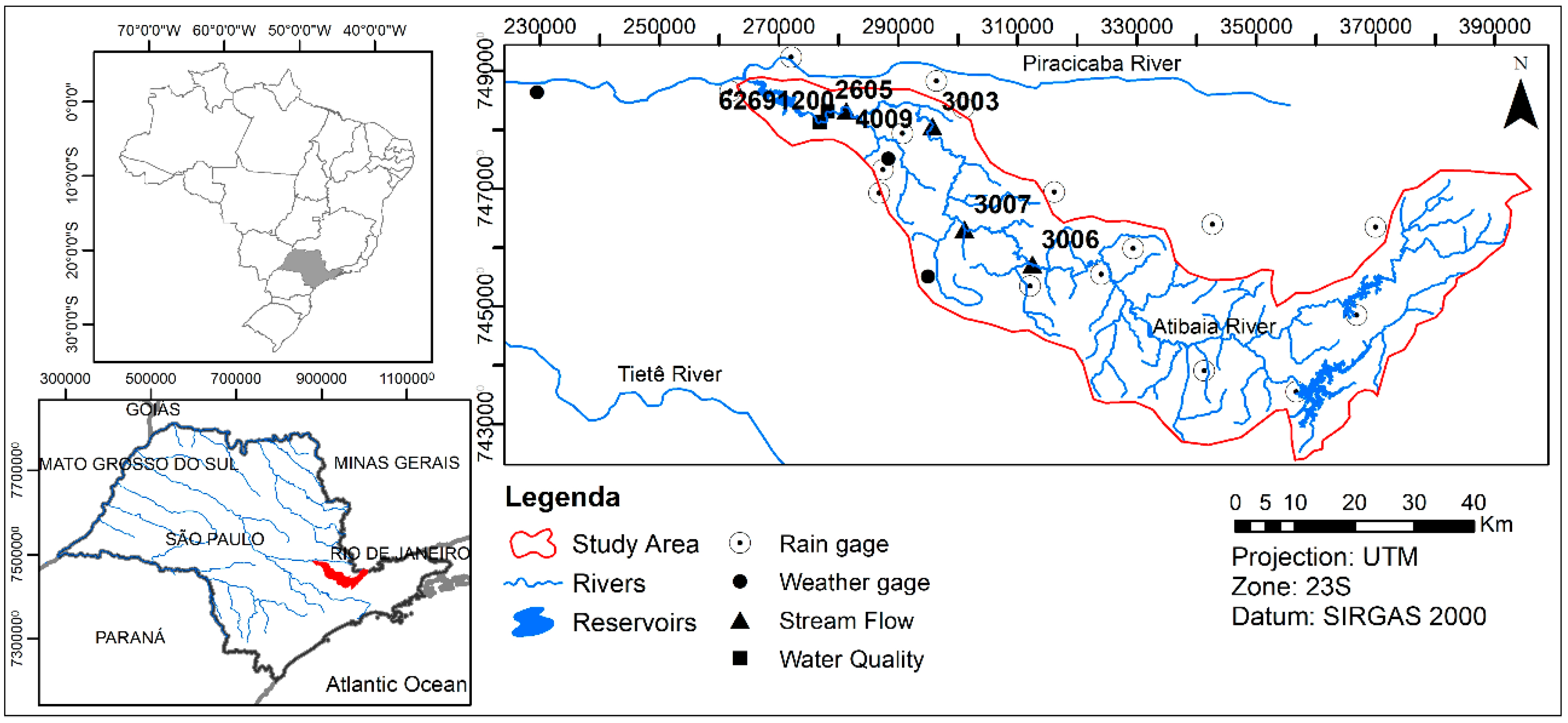
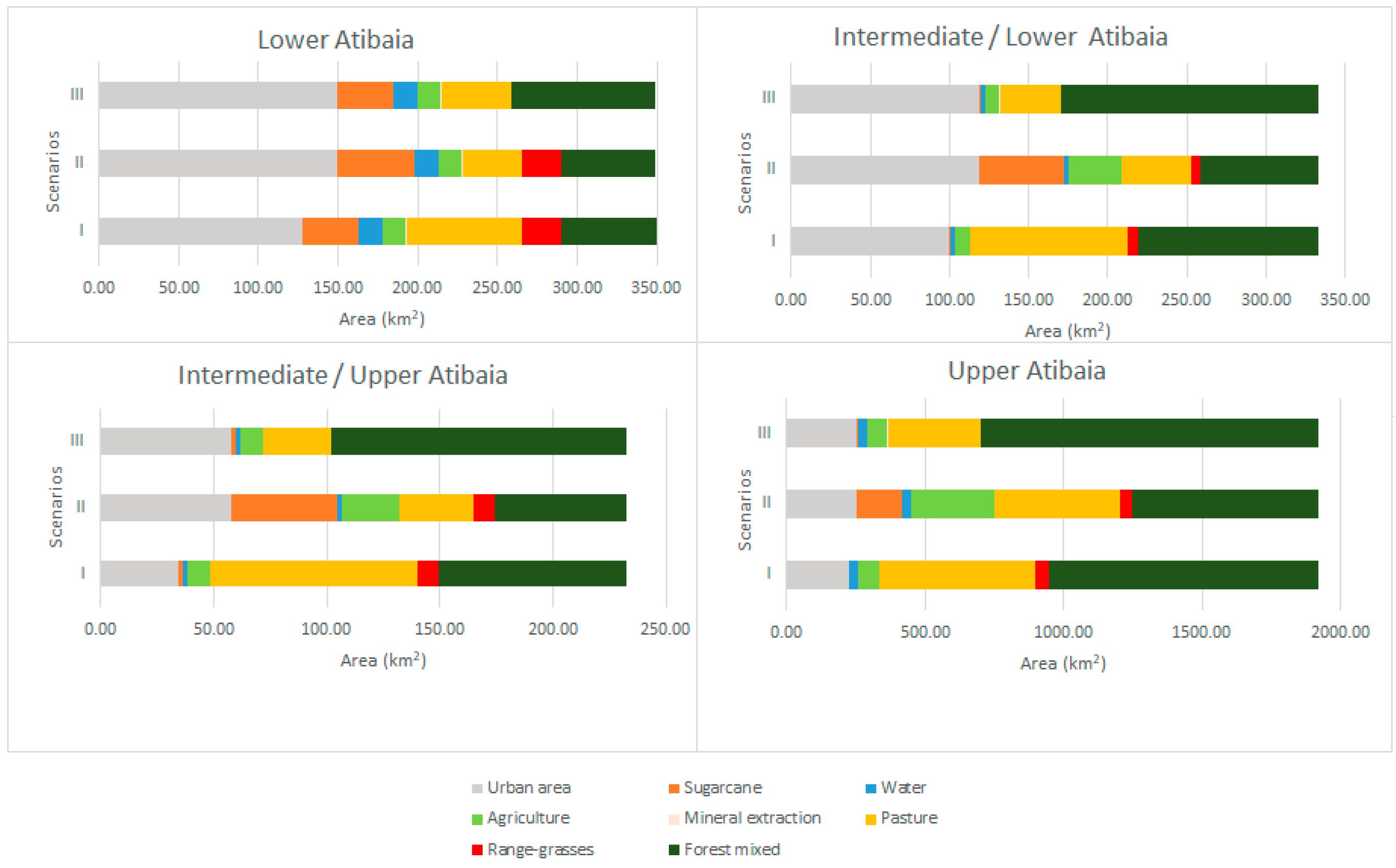
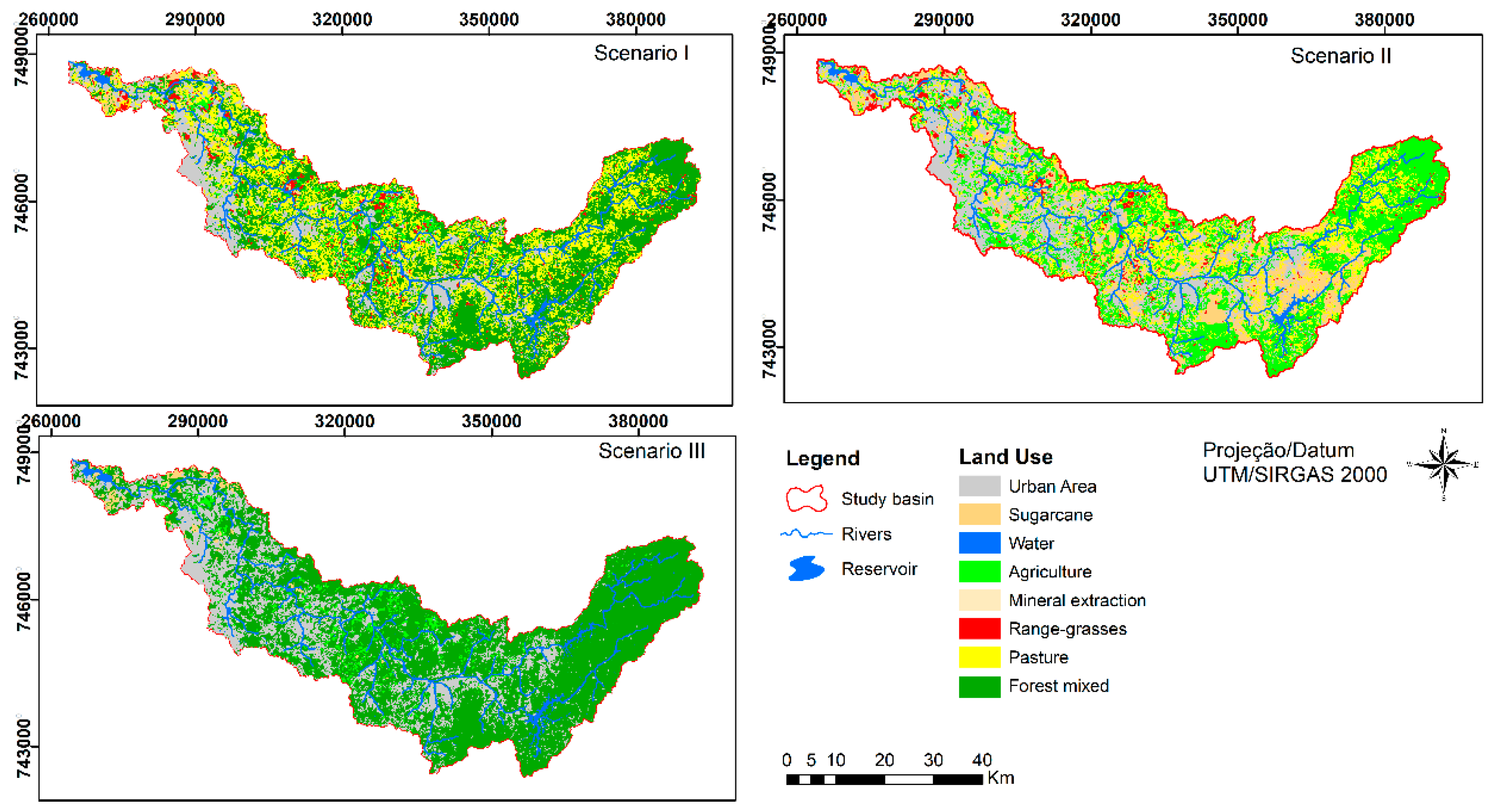

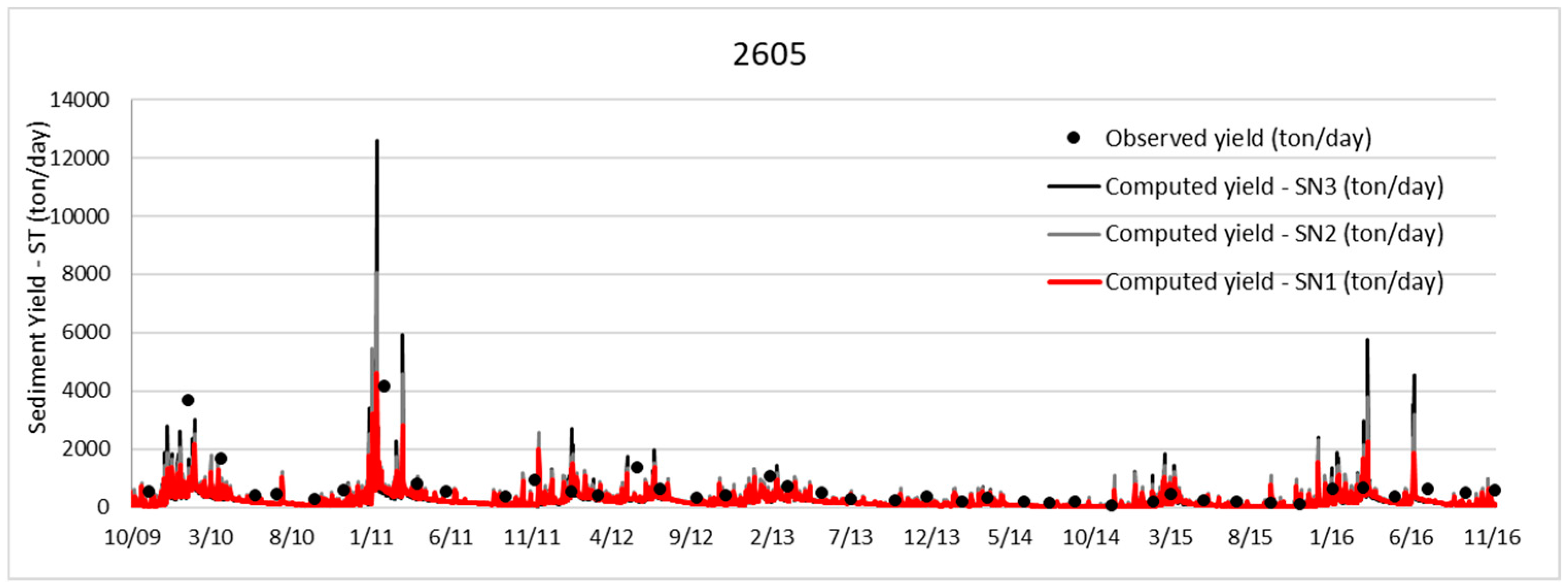

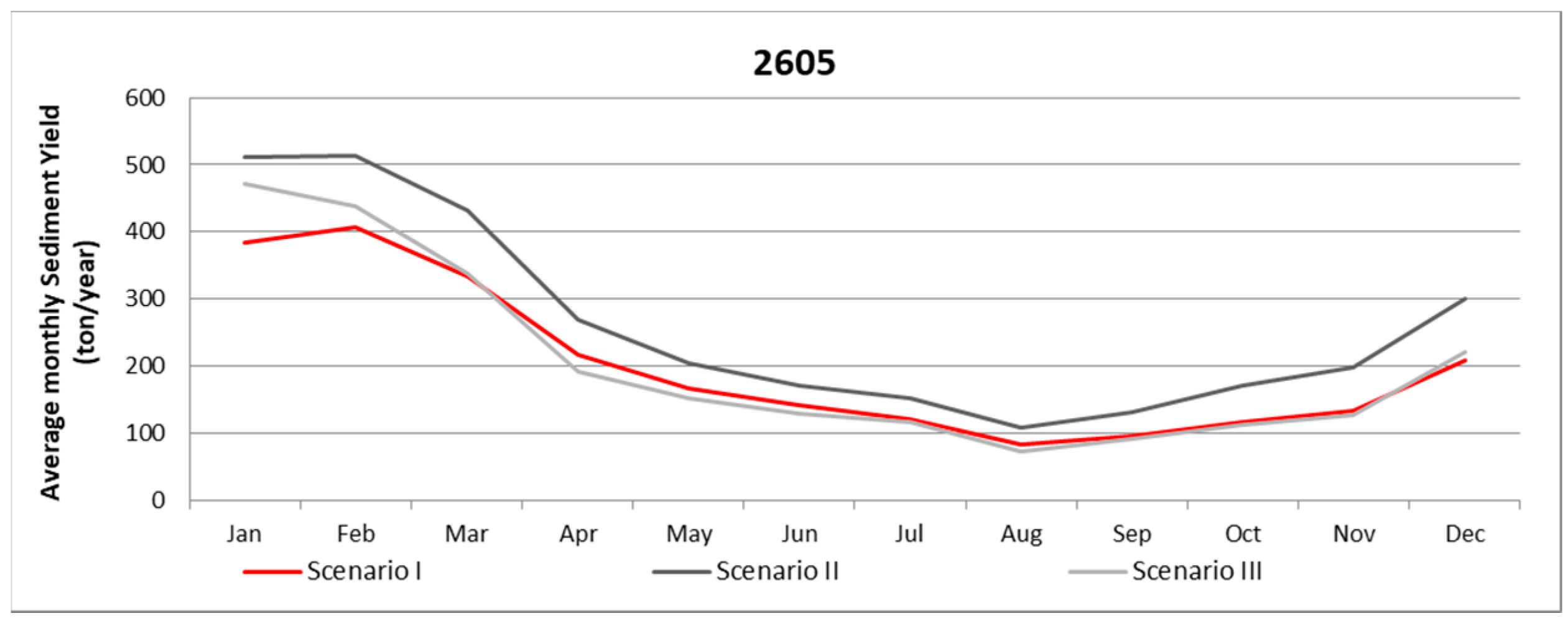
| SWAT Components | Description |
|---|---|
| Hydrology | Four main processes are considered: runoff, evapotranspiration, soil water movement and groundwater. All of these processes are accounted for in the model’s water balance equation. |
| Weather | Climate is the main process inducing agent of the terrestrial phase of the hydrological cycle. The model requires daily data and monthly data of various meteorological variables. |
| Erosion/Sedimentation | Sediment yield is calculated for each HRU using the Modified Universal Soil Loss Equation. Vegetation cover and crop residues are considered when estimating soil particles detachment and transport. |
| Land use and Plant growth | Plant growth is simulated using an Erosion Productivity Impact Calculator (EPIC) simplification and occurs only on days when the average daily temperature exceeds a plant-specific base temperature [22]. |
| Nutrients and Pesticides | Nitrogen and phosphorus movement and transformation is traced within the basin. In addition, pesticide loading, and bacterial contamination can also be computed. |
| Management practices | Crop cultivation, growth and grazing are simulated, as well as irrigation and nutrient and pesticide applications. Soil protection offered by vegetation throughout the year and the deposition of crop remains on the soil after harvest is considered. |
| Main channel processes | The movement of water, sediment, nutrients, and pesticides through the channel is computed. The channel dimensions are usually assumed constant, but there is an option to assume them dependent on erosion and deposition. |
| Water bodies | In addition to channels, water may flow through four types of water bodies: ponds, wetlands, depressions, and reservoirs. |
| Land Uses | Lower Atibaia (km2) | Intermediate Lower Atibaia (km2) | Intermediate/Upper Atibaia (km2) | Upper Atibaia (km2) | ||||||||
|---|---|---|---|---|---|---|---|---|---|---|---|---|
| Scen. I | Scen. II | Scen. III | Scen. I | Scen. II | Scen. III | Scen. I | Scen. II | Scen. III | Scen. I | Scen. II | Scen. III | |
| Urban area | 127.3 | 149.0 | 149.0 | 99.54 | 118.46 | 118.36 | 34 | 57.7 | 57.7 | 222.1 | 254.6 | 254.6 |
| Sugarcane | 35.3 | 48.6 | 35.2 | 1.33 | 53.67 | 1.33 | 2.0 | 47.0 | 2.0 | 1.9 | 160.0 | 1.9 |
| Mineral Extraction | 0.6 | 0.6 | 0.6 | 0.25 | 0.25 | 0.25 | 0 | 0 | 0 | 0.2 | 0.2 | 0.2 |
| Water | 15.4 | 15.4 | 15.4 | 3.01 | 3.01 | 3.01 | 1.9 | 1.9 | 1.9 | 33.9 | 33.9 | 33.9 |
| Agriculture | 14.3 | 14.3 | 14.3 | 8.88 | 33.33 | 8.82 | 10.2 | 25.6 | 10.1 | 73.6 | 299.5 | 73.5 |
| Pasture | 72.3 | 37.4 | 43.6 | 100.03 | 43.64 | 38.27 | 91.8 | 32.8 | 30.4 | 566.3 | 455.2 | 336.9 |
| Range-grasses | 24.9 | 24.8 | 0 | 6.05 | 6.05 | 0 | 8.8 | 8.8 | 0 | 46.4 | 46.2 | 0 |
| Forest mixed | 59.2 | 59.2 | 91.4 | 113.80 | 74.48 | 162.85 | 83.4 | 58.6 | 130.4 | 978.6 | 672.4 | 1221.0 |
| Lower Atibaia-4009 | Intermediate/Lower Atibaia-3003 | Intermediate/Upper Atibaia-3007 | Upper Atibaia-3006 | |||||||||
|---|---|---|---|---|---|---|---|---|---|---|---|---|
| Parameters | Scen. I | Scen. II | Scen. III | Scen. I | Scen. II | Scen. III | Scen. I | Scen. II | Scen. III | Scen. I | Scen. II | Scen. III |
| CN.mgt | 50.64 | 52.82 | 49.22 | 50.13 | 53.19 | 48.46 | 40.70 | 45.27 | 37.68 | 36.13 | 43.87 | 33.36 |
| CANMX.hru | 36.90 | 26.80 | 71.00 | 42.60 | 27.10 | 69.00 | 43.20 | 28.20 | 70.00 | 45.90 | 29.47 | 70.00 |
| USLE_C.crop | 0.001 | 0.1 | 0.0005 | 0.005 | 0.2 | 0.0004 | 0.005 | 0.14 | 0.0004 | 0.005 | 0.17 | 0.0004 |
| Parameters | Before SWAT Simulation | |
|---|---|---|
| t-Stat | p-Value | |
| CN.mgt | −1.82 | 0.31 |
| SOL.awc | −1.50 | 0.37 |
| CANMX.hru | 1.25 | 0.43 |
| GW_REVAP.gw | −1.13 | 0.46 |
| ESCO.hru | 1.11 | 0.47 |
| SURLAG.hru | −0.74 | 0.59 |
| ALPHA_BF.gw | −0.71 | 0.60 |
| SLSOIL.hru | 0.51 | 0.70 |
| CNCOEF.bsn | 0.45 | 0.73 |
| RCHRG_DP.gw | 0.41 | 0.75 |
| Parameters | Definition | Unit | Range | Default Value | Calibrated Value | |
|---|---|---|---|---|---|---|
| Water | GW_REVAP.gw | Groundwater “revap” coefficient | - | 0.02 to 0.2 | 0.02 | 0.04 |
| ALPHA_BF.gw | Base flow alpha factor | days | 0 to 1 | 0.048 | 0.001 | |
| RCHRG_DP.gw | Deep aquifer percolation fraction | mm | 0 to 1 | 0.05 | 0.12 | |
| CANMX.hru (Maximum canopy storage) | Urban area | mm | 0 to 100 | 0 | 15 | |
| Sugarcane | 40 | |||||
| Water | 0 | |||||
| Agriculture | 40 | |||||
| Mineral extraction | 0 | |||||
| Pasture | 20 | |||||
| Range-grasses | 20 | |||||
| Forest mixed | 80 | |||||
| ESCO.hru | Soil evaporation compensation factor | - | 0.01 to 1 | 0.95 | 0.6 | |
| SLSOIL.hru | Slope length for lateral subsurface flow | m | 0 to 150 | 0 | 40 | |
| SURLAG.hru | Surface runoff lag coefficient | - | 0 to 1 | 2 | 1 | |
| CNCOEF.bsn | Weighting coefficient for calculating retention dependent of plant evapotranspiration | - | 0.5 to 2 | 2 | 1.5 | |
| CN.mgt | Initial curve number for moisture condition II | - | 0 to 100 | Varies | 0.7 a | |
| SOL.awc | Available water capacity of soil layer | mm/mm | 0 to 1 | Varies | 0.7 a | |
| USLE_C.crop (The cover and management factor) | Sugarcane | - | 0 to 1 | 0.001 | 0.050 3 | |
| Water | 0 | 0 2 | ||||
| Agriculture | 0.2 | 0.200 1 | ||||
| Pasture | 0.003 | 0.0075 3,4 | ||||
| Range-grasses | 0.003 | 1 3 | ||||
| Forest mixed | 0.001 | 0.0004 1 | ||||
| Sediment | USLE_P.mgt | USLE support practice factor | - | 0 to 1 | 1 | 0.8 |
| CH_COV1.rte | Channel erodibility factor | - | −0.05 to 0.6 | 0 | 0.1 | |
| CH_COV2.rte | Channel cover factor | - | −0.001 to 1 | 0 | 0.1 | |
| LAT_SED.hru | Sediment concentration in lateral flow and groundwater flow | mg/L | 0 to 5000 | 0 | 3000 |
| Gages | Daily | Monthly | ||||||||||
|---|---|---|---|---|---|---|---|---|---|---|---|---|
| Calibration | Validation | Calibration | Validation | |||||||||
| NSE | Pbias | r2 | NSE | Pbias | r2 | NSE | Pbias | r2 | NSE | Pbias | r2 | |
| 3006 | 0.54 | 1.87 | 0.38 | 0.28 | −24.54 | 0.41 | 0.83 | 1.03 | 0.64 | 0.60 | −8.92 | 0.62 |
| 3007 | 0.48 | −10.00 | 0.43 | 0.36 | −14.04 | 0.47 | 0.79 | 7.71 | 0.83 | 0.70 | −4.93 | 0.71 |
| 3003 | 0.69 | −3.46 | 0.48 | 0.49 | −19.34 | 0.52 | 0.85 | −8.50 | 0.71 | 0.69 | −5.46 | 0.72 |
| 4009 | 0.75 | −21.21 | 0.60 | 0.60 | −16.65 | 0.54 | 0.96 | −4.94 | 0.90 | 0.81 | −15.84 | 0.80 |
| Gage | Sediment Yield | ||
|---|---|---|---|
| NSE | Pbias | r2 | |
| 2605 | 0.06 | 39.50 | 0.30 |
| Variable | 4009 | 3003 | 3007 | 3006 | ||||||||
|---|---|---|---|---|---|---|---|---|---|---|---|---|
| Scen. I | Scen. II | Scen. III | Scen. I | Scen. II | Scen. III | Scen. I | Scen. II | Scen. III | Scen. I | Scen. II | Scen. III | |
| P | 1594 | 1594 | 1594 | 1594 | 1594 | 1594 | 1404 | 1404 | 1404 | 1404 | 1404 | 1404 |
| PET | 1939 | 1939 | 1939 | 1939 | 1939 | 1939 | 1924 | 1924 | 1924 | 1924 | 1924 | 1924 |
| ET | 1032 | 966 | 1078 | 1009 | 953 | 1044 | 1021 | 951 | 1072 | 1076 | 1049 | 1112 |
| Revap | 77 | 77 | 77 | 77 | 77 | 77 | 58 | 58 | 58 | 54 | 54 | 54 |
| Perc | 474 | 527 | 381 | 449 | 469 | 342 | 221 | 235 | 151 | 116 | 121 | 99 |
| SurQ | 45 | 56 | 100 | 66 | 100 | 153 | 3 | 58 | 72 | 29 | 54 | 63 |
| GwQ | 348 | 396 | 260 | 327 | 345 | 225 | 137 | 150 | 76 | 49 | 57 | 39 |
| LatQ | 42 | 45 | 34 | 69 | 70 | 54 | 161 | 162 | 111 | 186 | 182 | 134 |
| Deep | 57 | 63 | 46 | 54 | 56 | 41 | 26 | 28 | 18 | 14 | 15 | 12 |
| Flow_out | 444 | 517 | 412 | 482 | 538 | 447 | 314 | 378 | 271 | 283 | 300 | 243 |
| Gage | Annual Average Sediment Yield (ton/year) | ||
|---|---|---|---|
| Scenario I | Scenario II | Scenario III | |
| 2605 | 73941 | 97078 (+24%) | 75806 (+2%) |
© 2020 by the authors. Licensee MDPI, Basel, Switzerland. This article is an open access article distributed under the terms and conditions of the Creative Commons Attribution (CC BY) license (http://creativecommons.org/licenses/by/4.0/).
Share and Cite
Mendonça dos Santos, F.; Proença de Oliveira, R.; Augusto Di Lollo, J. Effects of Land Use Changes on Streamflow and Sediment Yield in Atibaia River Basin—SP, Brazil. Water 2020, 12, 1711. https://doi.org/10.3390/w12061711
Mendonça dos Santos F, Proença de Oliveira R, Augusto Di Lollo J. Effects of Land Use Changes on Streamflow and Sediment Yield in Atibaia River Basin—SP, Brazil. Water. 2020; 12(6):1711. https://doi.org/10.3390/w12061711
Chicago/Turabian StyleMendonça dos Santos, Franciane, Rodrigo Proença de Oliveira, and José Augusto Di Lollo. 2020. "Effects of Land Use Changes on Streamflow and Sediment Yield in Atibaia River Basin—SP, Brazil" Water 12, no. 6: 1711. https://doi.org/10.3390/w12061711
APA StyleMendonça dos Santos, F., Proença de Oliveira, R., & Augusto Di Lollo, J. (2020). Effects of Land Use Changes on Streamflow and Sediment Yield in Atibaia River Basin—SP, Brazil. Water, 12(6), 1711. https://doi.org/10.3390/w12061711






